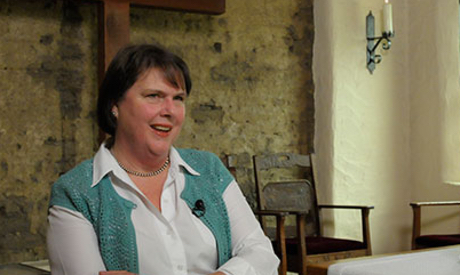“Mary,” Jesus said to her. When she heard him call her name, she responded, “Rabbouni!” Teacher.
“Go to my brothers,” he said, delivering a direct commission to announce the “good news.”
“I have seen the Lord,” she told the disciples.
In our parish in Northern California, lay women began to preach the good news during the Sunday liturgy in 1996.
The practice emerged from within the faith community.
Several women had approached our pastor and spoke of the devastating lack of women’s spiritual wisdom and leadership in the church for 2,000 years.
We asked: Couldn’t women, who feel called and are prepared, give a homily—a teaching that expands on the message of the Scripture readings and invites listeners to a change of mind and heart?
“I wondered if anyone would ever ask,” he said.
Like Mary of Magdala, women who gave homilies had experienced a deep call and felt commissioned to share the good news.
We had discerned both with our spiritual directors and pastor.
All of us who were lay preachers had studied theology at the university level—some had earned a masters of divinity degree.
Some were or had been members of a religious order or had special knowledge of a particular pastoral issue within our parish community. We had demonstrated an expertise or experience of the lay faithful, as required by Canon Law (No. 766).
Members of the congregation told us they were eager to hear our words.
One parishioner said to me: “Hearing a Catholic woman reflect on the Word during Sunday’s liturgy is a breakthrough experience for women and for men. It strengthens us as the body of Christ.”
We felt that the church, local and universal, recognized in us the gifts bestowed on us by the Spirit—the fresh perspectives we contributed to the community—just as the early Christian church had recognized women’s leadership.
Each time one of us preached, the pastor who had first invited us wrote a two-page, single-spaced letter to whomever had spoken, warmly commenting on the delivered homily.
Once a year, the parish priests invited us lay preachers to dinner at the rectory, where together we discussed what went well and what we might do better.
We women felt enmeshed in the prophetic leadership of the parish.
Parishioners might say, as the townspeople of Samaria did 2,000 years ago, “We believed in Him on the strength of the woman’s testimony” (Jn 4:3).
In 2001, the United States Conference of Catholic Bishops, in accordance with No. 766 of the 1983 Code of Canon Law, declared that “preaching by the lay faithful may not take place within the Celebration of the Eucharist at the moment reserved for the homily.”
Nevertheless, the conference recognized the right of each bishop to permit the practice of lay preaching in his own diocese, though not during the time traditionally set aside for the homily.
Like Mary of Magdala, women who gave homilies had experienced a deep call and felt commissioned to share the good news.
Our bishop and our parish priests, years earlier, had recognized the gift of lay preaching.
Nobody expected that the clock might be turned back.
But in 2009, restrictions began to be put in place.
A new bishop in our diocese mandated that the priest celebrant must read the Gospel at Mass and he alone give a short homily. Lay people could then offer a “reflection,” sharing our thoughts. But we could not give a homily.
The congregation was stunned. Continue reading
- Jean Molesky-Poz is a Religious Studies lecturer.
- Image: SantaClara Magazine
